DIY drain pit from tires: step-by-step instructions for arranging
The desire to add urban comfort to the country life encourages many summer residents, and the owners of suburban real estate, to arrange the water supply on their own site. But a full-fledged water supply system is impossible without a sewage system, right?
It turns out that you can make an autonomous sewage system yourself from improvised materials. One of the popular home-made structures is a drain pit made of tires, used to collect and filter effluents. The device and installation of the structure are very simple, but the efficiency and safety of the operation of the system is achieved only with strict observance of technological standards.
In this article, we will talk about how to choose a place for a cesspool, and what you need to take into account. Also, here you will find step-by-step instructions for constructing a cesspool of automobile tires. The material is accompanied by arrangement schemes and videos with expert advice on the construction of drain pits.
The content of the article:
The device and principle of operation of the sump
Cesspool - the simplest arrangement autonomous sewer. With the advent of highly efficient septic tanks and local purification systems, the use of drain collectors in private households and cottage villages has declined. However, among summer residents, this method of wastewater removal remains in demand.
The most budgetary and easiest to implement local sewerage system is based on the use of old tires. In this case, the walls of the drain collector are reinforced with rubber tires, the bottom of the tank is missing.
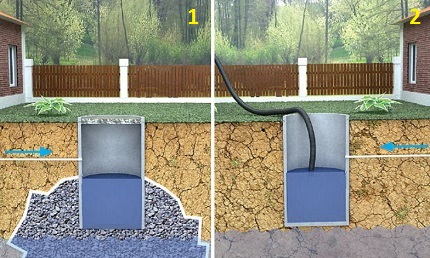
The base of the absorbing, or otherwise filtering option is a drainage layer of crushed stone and sand. The stability of the structure is achieved due to the weight of the tires themselves, land sprinkling and accumulated wastewater.

The principle of operation of the absorbing hole:
- Sewage liquid enters the tank through a pipe.
- Heavy, solid suspensions settle on the surface of the “pillow” from crushed stone.
- Semi-purified water seeps through the drainage layer and passes deep into the soil.
- The accumulated sludge is periodically pumped out of the tank.
To improve the quality of filtration and accelerate drainage of drains, a hollow perforated pipe is installed inside the tank from the tires.
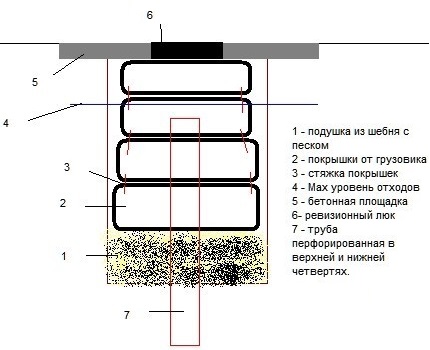
The desirability of a drain collection of tires
When planning the construction of a cesspool from car tires, it is necessary to compare the features of the arrangement, the efficiency of the drain collector with the expected operating conditions and the "loads" on the sewer system.
The main arguments in favor of a well from rubber products:
- Low cost. Used tires can be obtained for free - there are many old tires for recycling at a car service or trucking company. In an extreme case, worn out automobile tires will turn out to be purchased for almost a penny at a flea market. The main expense item is the arrangement of the supply pipeline.
- Easy installation. Material preparation, installation and connection of a drain tank is a feasible task for one person. The work does not include the use of expensive tools and equipment.
Rubber does not lend itself to corrosion, so the pit will last longer than a structure made of metal barrels. The average life is 10-12 years.
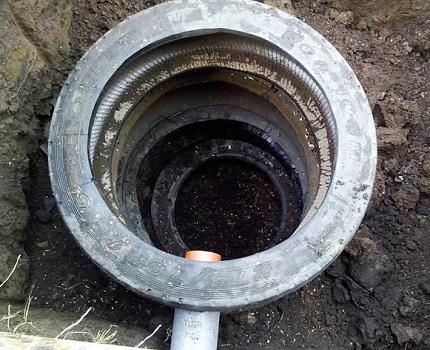
“Artisanal” sewage treatment plant has a number of negative factors limiting its use:
- Low productivity. Even very large tires are not able to provide sufficient volume for the accumulation and disposal of wastewater. An absorbing tire pit is suitable for a family of two to three people.
- Freezing system. Despite the use of heat-insulating materials in severe frosts, the rubber becomes frosty, which is fraught with freezing of drains and stopping the sewage system.
- Bad smell. From time to time, from the side of the cesspool, “aromas” of sewage can be heard. To fix the problem, install a fan vent pipe and cover the hatch with a tight lid.
- Limited use. The degree of wastewater treatment by an absorbing pit reaches 40% - this is not enough for safe drainage into the ground. In order not to disturb the ecological balance, heavily contaminated liquid and fecal matter cannot be discharged from the tires into the drain pit.
- Lack of tightness. To ensure complete impermeability of joints between tires is quite difficult. During soil movements and after cleaning, there is a high probability of depressurization of the structure - sewage begins to seep into the soil.
Loss of tightness is the most common cause of a malfunction in the sewer system.
Possible solutions to the problem: overhaul of the structure after cleaning or the complete dismantling of the rubber well, followed by the erection of a trench from new tires.
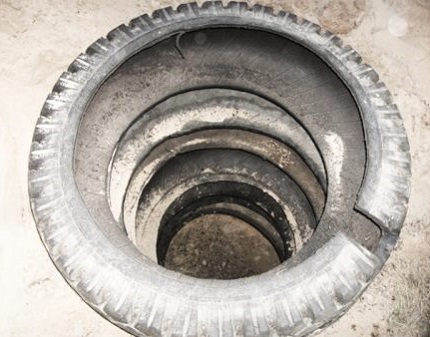
It is advisable to erect an absorbing well from tires under the following conditions:
- the volume of wastewater does not exceed 1 cubic meter / day;
- the groundwater level on the site is at a depth of 2 m;
- it is preferable to equip a cesspool without a bottom on light, well-drained soils (sand, sandy loam), and slope stagnant water on heavy substrates (clay).
The construction of the pit is advisable for a summer cottage, sauna or seasonal bath.
Choosing a place for the drain pit
When constructing a drain pit, one should be guided by the norms set out in SanPiN 42-128-4690-88. The document clearly defines the permissible boundaries of the placement of the sewer system on the site.
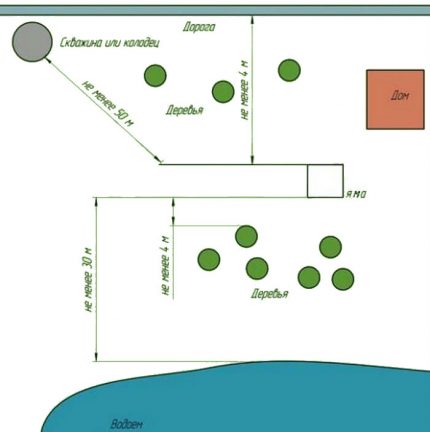
Additional, but no less significant, restrictions on the distance of the reservoir with sewage:
- The distance to the water pipes depends on the direction of groundwater movement. You can approximately determine the direction by the slope of the relief. When water rushes from the drain pit, the minimum distance between the designated objects is 40 m, otherwise - at least 25 m.
- The nearest well or deep well with drinking water should be 50 m or more. In practice, compliance with this norm is very difficult. With the permission of the SES, this distance is reduced to 30 m.
- Distance to an open reservoir - at least 30 m.
- The distance between trees, shrubs and a cesspool is 4 m. The same parameter is defined for the roadway.
- The remoteness of the treatment plant from the neighboring site is about 3 meters.
The optimal location of the pit is in the lowlands in the direction of groundwater. To reduce the likelihood of an unpleasant smell penetrating into the housing, a container with sewage is constructed on the leeward side, away from the house.
When planning, it is necessary to ensure unhindered access of cleaning equipment to the cesspool.

Technology for the construction of a cesspool of tires
Below is a step-by-step instruction on creating a drain pit with a drainage well. The material for the arrangement of the absorbing well is old tires.
The process of constructing a drain structure from old automotive rubber involves a number of traditional steps:
Stage # 1. Calculation of the volume of the drain tank
The primary task of constructing an autonomous treatment system from tires is to calculate the volume of the drain tank to determine the number and dimensions of tires used. The volume of the camera depends on the number of people living in the house.
According to regulatory data, one adult spends about 170-200 liters of water per day (for bathing, washing, cooking, etc.). If we take the condition that the family consists of three people, then the daily volume of effluents will be about 600 liters (0.6 cubic meters).
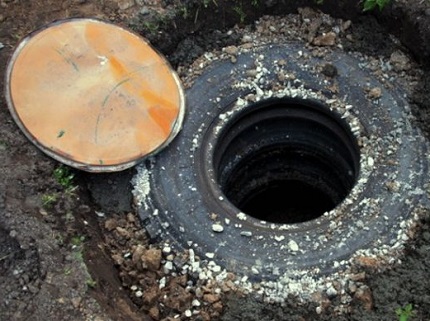
So, the obtained value (0.6 cubic meters) is multiplied by three. In total, the tank capacity should be 1.8 cubic meters. However, for the accuracy of the calculations, the type of soil should be taken into account. When arranging a cesspool on a porous substrate, the volume of the "rubber" tank can be reduced by 20%. In case of dense soil - increase by 10%.
To calculate the number of tires, you need to determine the volume of one tire. This is easy to do, knowing the diameter and height of the tire.
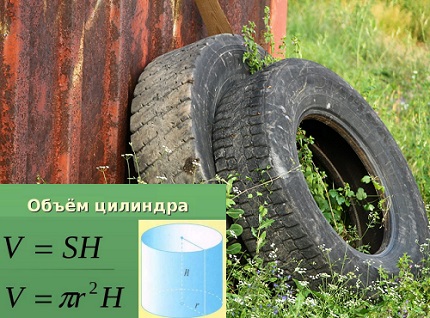
Stage # 2. Preparation of materials and tools
For independent construction of an absorbing pit and supply of communications to it, one should stock up with tools and materials. Earthwork is carried out using different types of shovels.
Shovel. Thanks to the design of the curved ladle, it is convenient to pick up and remove the earth from the ditch. If the metal sheet of the shovel bends, it can be reinforced with additional sides.
Bayonet shovel. It is used at the beginning of digging, so a tool with a standard length handle (1.5 m) is suitable.
"Digger". Shovel-ripper with a long holder, the design resembles a double fork. The tool is designed for loosening hard layers of soil.
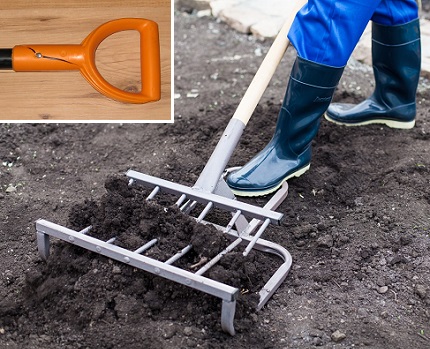
Indicative list of materials:
- Tires. Tires from a tractor, trucks or cars will do. At high groundwater it is better to use large-diameter products - it will be possible to obtain the desired volume without deepening to groundwater.
- Crushed stone, gravel and sand. Materials are needed to equip the filter bottom of the tower from tire covers.
- Sewer pipes. For the assembly of the pipeline, double-layer polyethylene or propylene pipes with a diameter of 110 mm are suitable. In addition, you need to purchase corrugations, tees, plugs and fittings.
- Cap. Plastic insulated model is suitable sewer manhole. The diameter is selected in accordance with the dimensions of the drain pit.
- Film waterproofing and concrete mortar. Materials are necessary to ensure the tightness of the tank - the outer slots of the "pyramid" are coated with a solution, and the inner surface of the walls is lined with a film.
- Plastic or concrete pipe. It deepens into the drainage layer and acts as a filter element.
For installation work you will need: a cutter or jigsaw, tape measure, building level, garden drill, stairs, bucket and rope.
Stage # 3. Sewer pipe outlet
The organization of a local treatment system begins with the arrangement of the release. Subsequently, the riser is assembled in the house, the tees and outlet pipes are connected. In an old building, the withdrawal of a sewer pipeline is through an underground or cellar.
If the exhaust channel is not provided in advance in the new house, you will have to dismantle the floor and make a hole in the foundation.

The depth of the pipeline at the exit from the house should be at least 60 cm, optimally 1 m. If in some areas the depth of the trench is less than 90 cm, then the pipeline must be insulated. Read more about the depth of sewer pipes Further.
Stage # 4. Earthwork
As a pattern for marking the boundaries of the pit, one of the tires is used. The tire should be put in the chosen place and pegs should be set around the circumference of the circle. So that in the future tires fit freely in the pit, the diameter of the ring must be expanded by 20-40 cm.
At first, it is convenient to dig the earth with a bayonet shovel. The fertile soil layer (the first 50 cm) can be evenly distributed throughout the garden, deeper earth layers can be used for backfilling.
It is easier to continue digging a deep foundation pit with a shovel with a long handle - compacted soil is loosened with a "digger", then it is collected with a shovel and loaded into buckets. To descend into the ditch and raise the filled containers to the surface, a ladder descends into the mine.
Working together, the digging process can be accelerated and a primitive lifting mechanism can be built - a rope is attached to the buckets.
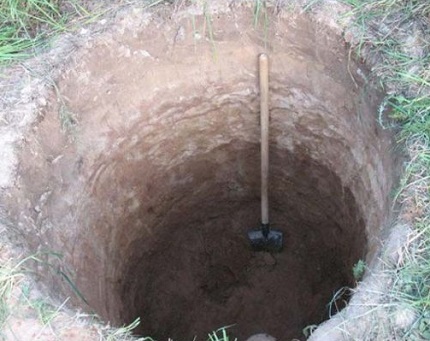
For safety, earthwork at a depth should be carried out with a partner. One person is engaged in digging, and the second helps on the surface and insures against the collapse of the walls of the pit. This requirement is especially relevant when arranging a hole in unstable soils.
Stage # 5. Harvesting tires
Concerning the technology for preparing tires for the construction of a cesspool, the opinions of the performers were divided. The first group believes that there is no need to do any manipulations with the tires, since the complete or partial removal of the tread will adversely affect the stability of the segments and the tightness of the structure as a whole.
However, the preservation of the sides of the tires worsens the operation of the absorbing pit - the useful volume of the tank is significantly reduced, and waste accumulates in the formed "pockets" very quickly. At the same time, it is practically impossible to qualitatively clean the sludge from the relief walls - the tank quickly overflows with sewage, and the sewage system fails.
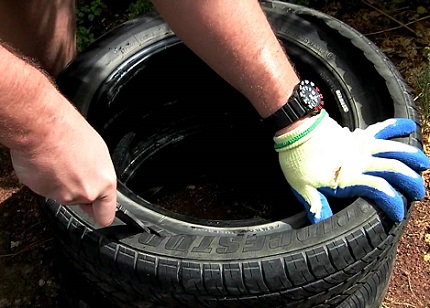
In one tire, you need to cut a hole to bring the sewer pipe.
Stage # 6. Drainage well formation
At a depth, very often the soil is heavy, clay, poorly absorbing and moisture-permeable. To increase the absorption area of the waste fluid and improve the efficiency of the absorbing trench, one or more drainage channels are installed.
Work progress:
- Drill a hole as deep as possible with a garden drill - the channel must pass through dense rocks that slow down the outflow of filtered water. The depth of the trench from the bottom of the pit is up to 3-5 m.
- Prepare a pipe corresponding to the length and diameter of the drainage channel. So that the filter pipe does not silt, its upper edge should be 1 m above the base of the drain pit.
- The side walls of the pipe, starting from the top and not reaching 50 cm to the bottom, are drilled. The top of the channel is closed with a fine-mesh polypropylene mesh.
After casing the drainage well, i.e. installation of a perforated pipe into the drilled trunk, a layer of rubble and gravel is poured onto the bottom of the pit - the thickness of the filter pad is about 20-30 cm.
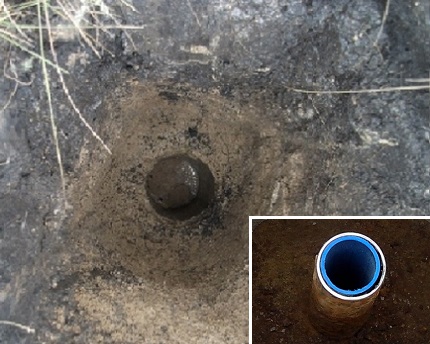
Stage # 7. Tire installation and wall sealing
At the bottom of a kind of mine the first tire is placed, passing through it drain pipe. Similarly, the second tire lowers into the pit, and the sides of adjacent wheels are connected in a convenient way.
Comparing and aligning both tires, it is necessary to make through holes in the protectors. Pass through them a metal wire or plastic clamp, and twist tightly.
During the construction of the tower, external joints are sealed - the joints of the tires are treated with concrete mortar or bitumen mastic. After setting the mixture, you can begin to backfill the pit.

The end face of the last tire should rise slightly above the ground. At the end of laying all the tires, the walls of the tank are covered with water-insulating material from the inside. The most affordable hydrobarrier option is a suitable sealant in composition.
Stage # 8. Final arrangement
A small embankment is made along the perimeter of the sides of the finish tire and rammed - a peculiar blind area is obtained, which prevents the penetration of rainwater into the trench. The tank on top is closed by a insulated hatch.
Through the plastic cover, you can remove the ventilation pipe. The length of the outer part of the ventilation duct must be at least 60 cm to ensure normal traction.
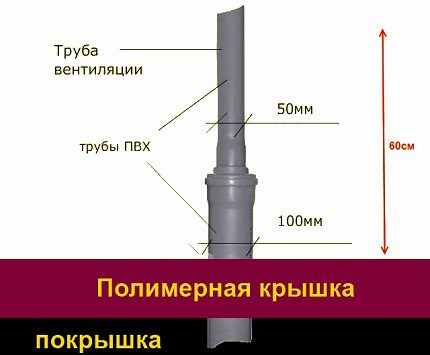
In order not to degrade the thermal and waterproofing properties of the hatch, the sewer hood can be made in another way. In the closing tire, a hole must be cut out and a “G” -shaped ventilation sleeve with an outlet to be installed. These works are carried out before filling the foundation pit.

Conclusions and useful video on the topic
Manufacturing technology of a cesspool of tires from the main and side drainage on the walls:
The device of a homemade drain pit for a summer residence:
The “handicraft” version of the cesspool is simple and accessible in the structure.However, when using it, the risk remains that part of the sewage will go into the ground without filtration, since the design of the tires does not guarantee complete tightness. The construction of an absorbing trench from tires is justified only in rare cases.
Trying to equip a drain pit from car tires yourself, but have any questions during the work? Or maybe they found flaws in the material or is there valuable information which you can share with visitors to our site? Please leave your comments at the bottom of the article.

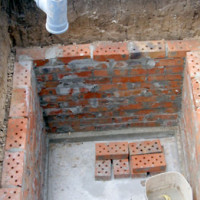 Do-it-yourself pit in a private house: how to dig and equip yourself
Do-it-yourself pit in a private house: how to dig and equip yourself 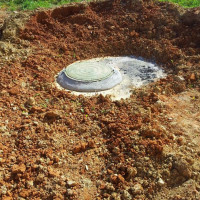 How to build a cesspool of tires: step-by-step technology of self-construction
How to build a cesspool of tires: step-by-step technology of self-construction 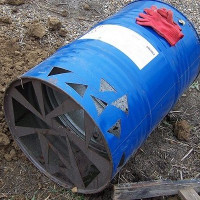 Barrel pit: step-by-step master-class on arrangement
Barrel pit: step-by-step master-class on arrangement  Do-it-yourself cesspool: analysis of popular options for arranging
Do-it-yourself cesspool: analysis of popular options for arranging  How to build a drain pit of brick: options and methods of arrangement
How to build a drain pit of brick: options and methods of arrangement  An overview of the Sanex product line for cesspools: reviews and instructions for use
An overview of the Sanex product line for cesspools: reviews and instructions for use  How much does it cost to connect gas to a private house: the price of organizing gas supply
How much does it cost to connect gas to a private house: the price of organizing gas supply  The best washing machines with dryer: model rating and customer tips
The best washing machines with dryer: model rating and customer tips  What is the color temperature of light and the nuances of choosing the temperature of the lamps to suit your needs
What is the color temperature of light and the nuances of choosing the temperature of the lamps to suit your needs  Replacement of a geyser in an apartment: replacement paperwork + basic norms and requirements
Replacement of a geyser in an apartment: replacement paperwork + basic norms and requirements
In my opinion, this option of a cesspool for a summer residence is almost ideal, both in cost and in labor costs. So I did, constructing an object for collecting domestic wastewater on a hacienda. At a cost of about three thousand, taking into account the fact that the ramps I had were available. I dug it myself, spent three days on everything about everything. The only thing I fear is freezing in winter, although in winter I do not go there so often. So, I hope that everything will be fine, and our winters are not so severe.
I strongly disagree with you. Yes, it is inexpensive in cost and a little fuss with it, but tightness in such a design is very difficult to achieve. Think about the ecology in your area, you yourself make a source of infection. And if you decide to put a well or a well on the site over time? And if your neighbors already have a well and people drink water into which your effluents fall? And all this because you were sorry for the money or time to do fine.
So I appeal to you and others who want to make such a drain hole - think again, and so we have ecology so-so, let us at least not aggravate the situation!
Something remained incomprehensible, the tires laid on top of each other are a reservoir (this same drain pit) into which the sewage system will merge. Will impurities accumulate in the tires themselves, even when filling them with gravel, emitting unpleasant odors, especially when they are constantly moistened with drained liquids? I would like to know how it looks in practice.
Alexander, you ask the right questions. The design is far from ideal. I made such a hole out of tires, its only advantage: simplicity and cheapness. Although I had to tinker with the joints, it was not so simple. But after six months, I felt all the charm on myself: the pit quickly fills up, the aromas due to rubber intensify, in the winter with a slight minus it already freezes. As a result, I took it all apart and made a normal drain hole from concrete rings.
Hello. As a rule, sediment remains on the tires themselves when filling the pit, solid sewage goes to the bottom, creating a siltation effect over time. If you throw paper and wet wipes into the sewers, they will cling to the edges, although in general, it is absolutely impossible and impractical to do this because of the complexity of the subsequent cleaning and quick filling of the compact pit.
My personal conclusion is that this arrangement method is ideal for a small family when it has time to dry out the soil. It is not suitable for a family of 5 people - the bottom is silty, the soil is saturated, the water is overflowing.You can clean the bottom with bio and chemical reagents, but these methods also have their drawbacks. Do not clean the siltation - the first wash and the pit is filled again.
I have had such a sewer for over 20 years. The first time had to be cleaned only 2 years ago and only because the bottom was silted up. It is not advisable to throw paper into the sewer. And the rest is no problem. Cheap and cheerful.